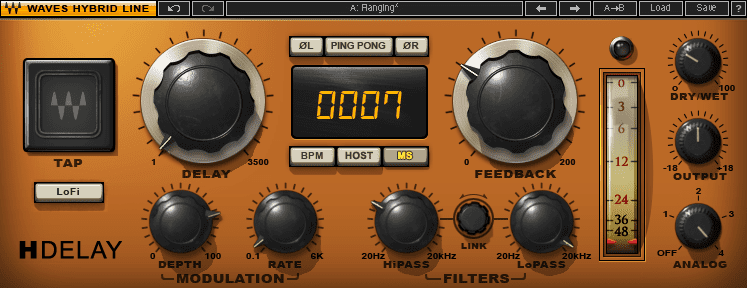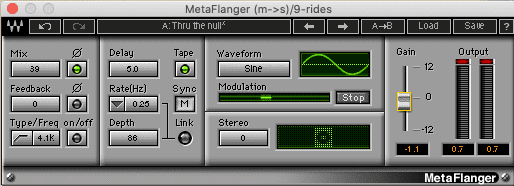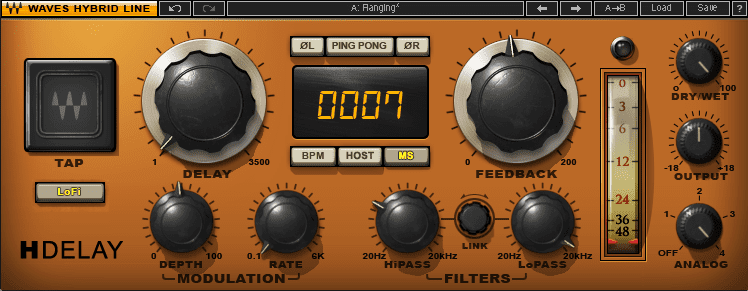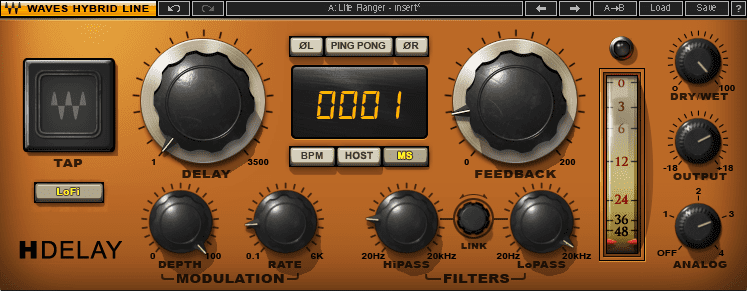In this tutorial, we show you how to add flanging to techno drums to create a number of effects, from subtle movement to psychedelic swirls.
Flanging is a useful effect that has fallen somewhat out of favour lately. It can be especially effective on drums, where it can add a feeling of movement to otherwise static programming. It’s also capable of getting pretty wild and out-there, making it an excellent go-to effect for instant trippy vibes.
Characterised by a hypnotic, metallic rising and falling sound, flanging was first achieved by spooling up two copies of the same song or sound on different reel to reel tape players, and manually syncing them up by hand. The term “flange” comes from the act of pressing a finger on the flange (or edge) of a reel to slow down the tape. When the two identical sounds are combined, the parts that are slightly out of phase create a swirling effect. Check out the song ‘Itchycoo Park’ by the Small Faces to hear manual flanging in action.
Electronic flanging is accomplished by delaying the source signal less than 20 milliseconds. The position of the delayed signal is varied regularly to create a rising and falling effect. Users can control the speed and depth of the oscillation and sometimes even the shape of the wave. Note that flanging is not to be confused with phasing. While similar, phasing doesn’t use a delay, just phase shifting to create its effect.
Let’s look at five ways that we can use flange to liven up percussion in a techno track. Our beat was made in Native Instruments Maschine 2.0 using the stock 909 kit. We also added a bit of compression and saturation to give the sounds some presence. Click any image to see a larger version.
Here’s our beat without any flange.
Here’s our beat with all of the flange techniques applied at once. (This is admittedly overkill. In a real-life situation, you might want to restrict yourself to one or two elements. Or not—it entirely depends on the track and the effect you’re going for).
Technique 1
Basic Flanging
Adding flange to a single percussive element, such as hats or claps, was a common technique in classic house and older genres of dance music. Let’s use it on a clap line and see how it can add a bit of interest to an otherwise standard drum pattern.
Although Waves H-Delay is primarily a delay effect, it can also do flanging. We place one on the clap track as an insert and turn the delay down to 7 milliseconds. We turn the feedback dial to about 60—longer feedback in this situation will create a kind of ringing. It’s an interesting effect but it’s not what we’re after—yet.
We’re hoping for a slow, hypnotic oscillation so we turn the rate down to about 0.16 and the depth to 78. There shouldn’t be much low-frequency information in our clap sample but just in case we set the highpass knob to 140. We experiment with the Analog settings to find one that we like—4 sounds good. Lastly, we adjust the Dry/Wet knob to 28 so that the effect is audible but not out of control.
Our dry claps.
Our claps with flanging.
And in context with a beat.
Technique 2
Through-Zero Flanging
In normal electronic flanging, the speed of the delayed signal is altered, creating a rising and falling wave. In through-zero flanging, first, the original signal is delayed, and then the second is also slowed. The point at which the second signal crosses the first is the zero point. It continues to go past this point as it slows, creating an especially deep and rich flanging effect. Let’s see how it sounds on rides.
We create an instance of Waves’ MetaFlanger on our ride track. MetaFlanger has a useful preset called Thru The Null that can get us started.
We turn down the mix to around 40 so we don’t lose the power of the rides. We’re not trying to blow them away, just create a psychedelic shimmer. We adjust the rate to 0.25 using the drop-down menu, with a depth of 86. If that seems too fast, you can always experiment with slower speeds. Make sure the Tape button is engaged. That gives us the through-zero effect.
The triangle LFO is nice but we think a sine wave sounds better. Lastly, we up the gain to better hear our effect.
Our dry rides.
And with through-zero flanging.
Now with the full beat for context.
Technique 3
Stereo Flanging
Maceo Plex & Gabriel Ananda’s ‘Solitary Daze’ is a great example of flanging on drums. If you listen carefully, you can hear that there are actually two different flanging effects happening, one in each stereo channel. Let’s use a similar technique to add stereo flanging to our hi-hat drum buss.
We start by grouping two different closed hi-hats (each panned slightly apart) and open hats into a buss. We then create two send channels, with each going to a copy of Waves’ H-Delay, panned hard left and right.
On the left channel, we want a buzzy, ringing effect, so we choose a delay of 7 milliseconds, a depth of about 80, a slow rate of 0.1, and crank the feedback up to almost 100 for a pronounced ringing. On the right channel, we want something a little more subdued but still powerful, so we start with a very short delay of 1 millisecond, depth of 100, a rate of about 0.6, and feedback at 27. We set both to Analog mode 4 and hit the Lo-fi button to give them a unified sound. We make sure the Dry/Wet knobs are at full wet so all the effect comes through.
Here is the dry buss.
Here is the buss treated with stereo flange.
And the buss along with the rest of the beat.
Technique 4
Flanged Reverb
Until now, we’ve used flanging in isolation. Now let’s try combining it with other effects. First up, reverb.
We create a send track from our crash channel and place the standard Ableton reverb on it. We go with a big, wet reverb so we can hear the effect. Next, we slot MetaFlanger into the same track. We set the mix to 64—we don’t want to overwhelm the reverb, just give it some motion. We dial feedback to 50 and try it with the effect both in and out of phase. It sounds better out of phase so we leave the phase button engaged. We also turn on the filter and roll off highs at 18k.
We adjust delay to 0.6 and press the Tape button for through-zero flanging. We sync the rate to the DAW’s tempo at 0.50 with a depth of 100. We make sure the LFO is running in sine mode, and add a little stereo depth. A setting of 18 sounds good. Now, every time the crash sounds we get a splashy, oscillating flanging effect on our reverb. Lastly, we add a Waves H-Comp to the end of the effect chain to intensify the flanging.
Here’s the crash and reverb with no flanging.
And with.
And here it is with the beat for context.
Technique 5:
Flanged Delay
Our last technique involves placing a flange plugin after a delay. We have a second set of claps that double up the snare and we’d like to use a ping-pong setting on them to create a groove. We use H-Delay to cook up a nice stereo delay but it could use a little more fire. Let’s see how flange can heat things up.
We turn to MetaFlanger again, this time using it to dial in a slow, languid flanging effect. First, we dial in a rather lengthy (for a flanger) delay of 31 seconds and we hit the Tape button for that deep, through-zero effect—we just can’t get enough of that. We want a very slow rate so we choose 0.10, with a depth of 6. We go with a triangle waveform for our LFO and dial in some stereo width. About 100 sounds good. We want a pronounced sound so we go with a Mix setting of 86, feedback at a generous 51, and engage the filter to shelve off frequencies above 11 kHz. We don’t need to clutter up the top end.
Now our ping-pong claps have some extra shimmer and movement as well.
Here are the claps with delay but no flanging.
And now with flanging applied.
And in context with the beat.






